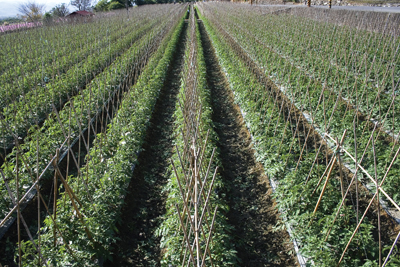
Features
Production
Research
Climate change presents opportunities and pitfalls
April 30, 2009 By Myron Love
Global warming has the potential for improved growing conditions for hard-pressed prairie vegetable growers but a Saskatchewan researcher cautions it brings potential pitfalls as well.

|
| Could long-season stake tomatoes such as these become a regular crop of choice in Saskatchewan? Global warming has the potential to improve growing conditions for Prairie vegetable growers but a Saskatchewan researcher cautions there could be potential pitfalls as well. |
Global warming has the potential for improved growing conditions for hard-pressed prairie vegetable growers but a Saskatchewan researcher cautions it brings potential pitfalls as well.
“A Minnesota climate for Saskatchewan may mean warmer temperatures and a longer growing season,” admits Dr. Doug Waterer, an associate professor with the department of plant science at the University of Saskatchewan. “But it also means new disease, weed and bug problems that will need to be addressed.”
Under current conditions – a short growing season and a cool climate – some vegetables, such as potatoes, carrots and cabbage, do reasonably well in Saskatchewan whereas others, such as melons and tomatoes, are riskier.
“They require more skill to grow them and tend to fail more often,” Dr. Waterer says. “You can’t fight Mother Nature.”
While he points out that global warning is not a foregone conclusion, Dr. Waterer admits the temperature trend seems to be toward warming, especially on the Canadian Prairies.
“Climate is changing on the prairies faster than anywhere else in the world,” he says. “If this trend continues, it will mean longer summers, a longer growing season and more frost-free days.”
In every crop, there are several different varieties available and in Saskatchewan, growers have tended to select for fast maturing varieties, not necessarily be the best quality. If the growing season was longer, growers could select better quality crops, says Dr. Waterer, adding a longer growing season would also result in higher yields and the possibility of trying different crops that are not well suited to the present climate.
While this may sound positive, Dr. Waterer points out that with a warming climate could be a trend toward a dryer growing season.
“This is already a region that doesn’t get a lot of rainfall,” he says.
“Irrigation could become much more important.
“At the same time, there could be more competition for water from a growing urban population and livestock operations.”
Dr. Waterer also notes that the current cold Saskatchewan winters kill off many troublesome insects and the shorter summers don’t give any insects that do survive much time to reproduce. That could change with a warmer climate, which might also attract new insects species, weeds and diseases to the region.
“A warmer climate will present new opportunities if growers manage change carefully,” Dr. Waterer says, adding new markets may open up in areas adversely affected by global warmer, such as the already dry American southwest.
Print this page